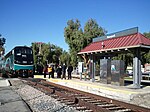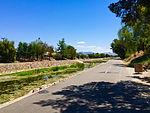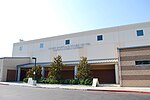Moorpark High School
1919 establishments in CaliforniaBuildings and structures in Moorpark, CaliforniaEducational institutions established in 1919High schools in Ventura County, CaliforniaMoorpark, California ... and 1 more
Public high schools in California
Moorpark High School is a comprehensive public secondary school located in the Mountain Meadows neighborhood of Moorpark, Ventura County, California, and serves students from grades 9 through 12. It is part of the Moorpark Unified School District; and had an enrollment of 1,908 students for the 2018–19 school year. The student/teacher ratio for 2017–18 was 23:1. Moorpark High School is accredited through the Western Association of Schools and Colleges. Moorpark High School takes pupils from two main feeder middle schools: Chaparral Middle School and Mesa Verde Middle School.
Excerpt from the Wikipedia article Moorpark High School (License: CC BY-SA 3.0, Authors).Moorpark High School
Pinedale Road,
Geographical coordinates (GPS) Address Nearby Places Show on map
Geographical coordinates (GPS)
| Latitude | Longitude |
|---|---|
| N 34.269722222222 ° | E -118.89805555556 ° |
Address
Pinedale Road
93021
California, United States
Open on Google Maps






